2013 YAMAHA AEROX50 wheel
[x] Cancel search: wheelPage 50 of 74
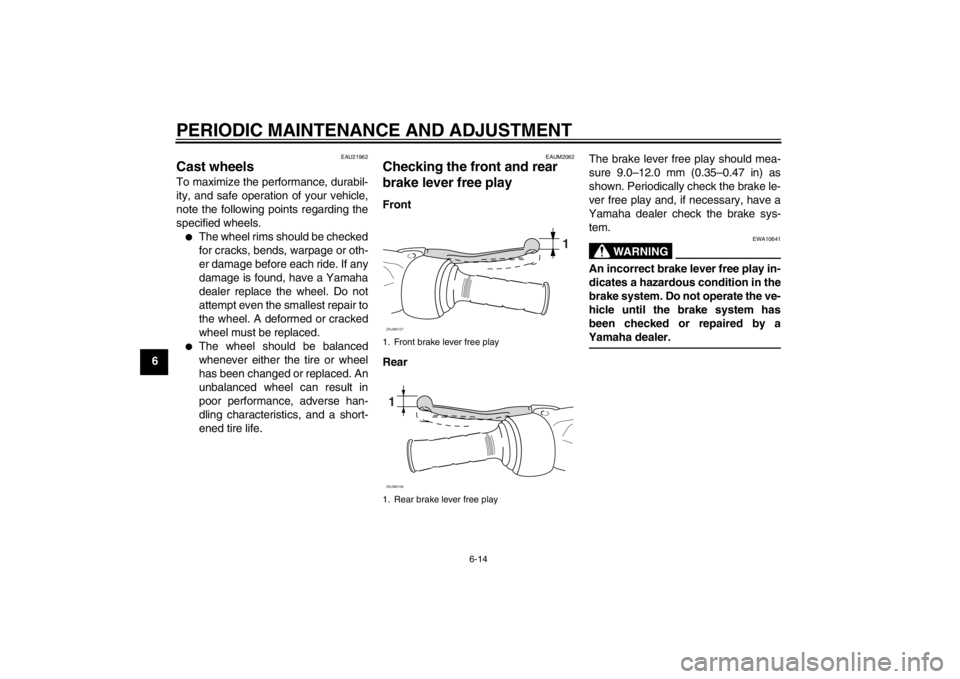
PERIODIC MAINTENANCE AND ADJUSTMENT
6-14
6
EAU21962
Cast wheels To maximize the performance, durabil-
ity, and safe operation of your vehicle,
note the following points regarding the
specified wheels.●
The wheel rims should be checked
for cracks, bends, warpage or oth-
er damage before each ride. If any
damage is found, have a Yamaha
dealer replace the wheel. Do not
attempt even the smallest repair to
the wheel. A deformed or cracked
wheel must be replaced.
●
The wheel should be balanced
whenever either the tire or wheel
has been changed or replaced. An
unbalanced wheel can result in
poor performance, adverse han-
dling characteristics, and a short-
ened tire life.
EAUM2062
Checking the front and rear
brake lever free play Front
RearThe brake lever free play should mea-
sure 9.0–12.0 mm (0.35–0.47 in) as
shown. Periodically check the brake le-
ver free play and, if necessary, have a
Yamaha dealer check the brake sys-
tem.
WARNING
EWA10641
An incorrect brake lever free play in-
dicates a hazardous condition in the
brake system. Do not operate the ve-
hicle until the brake system has
been checked or repaired by a
Yamaha dealer.
1. Front brake lever free play
1. Rear brake lever free play
1
ZAUM01071ZAUM0108
U1PHE0E0.book Page 14 Wednesday, August 29, 2012 4:42 PM
Page 55 of 74
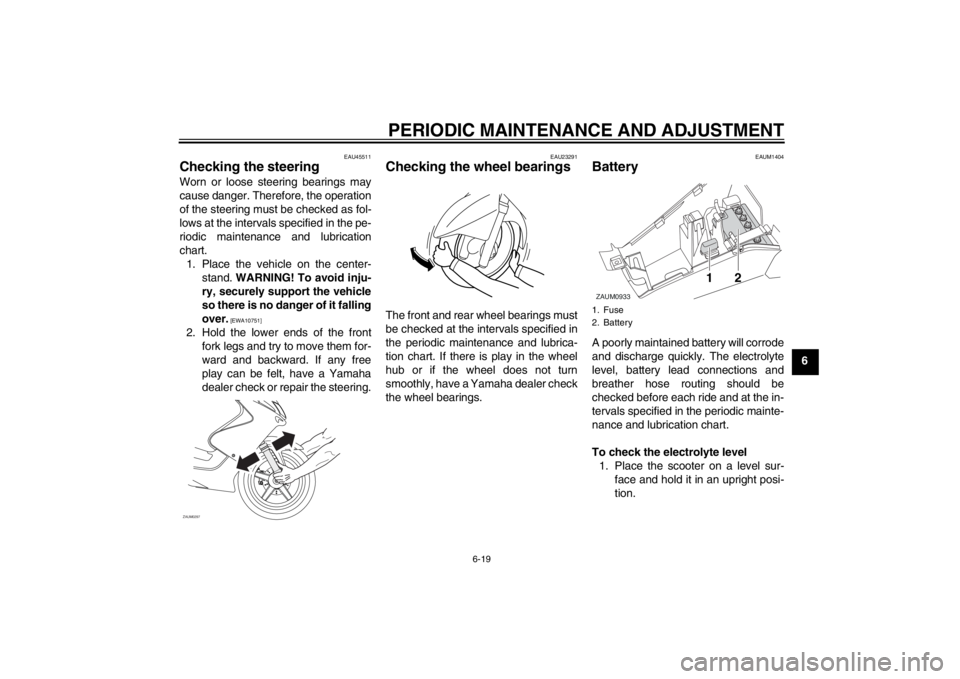
PERIODIC MAINTENANCE AND ADJUSTMENT
6-19
6
EAU45511
Checking the steering Worn or loose steering bearings may
cause danger. Therefore, the operation
of the steering must be checked as fol-
lows at the intervals specified in the pe-
riodic maintenance and lubrication
chart.
1. Place the vehicle on the center-
stand. WARNING! To avoid inju-
ry, securely support the vehicle
so there is no danger of it falling
over.
[EWA10751]
2. Hold the lower ends of the front
fork legs and try to move them for-
ward and backward. If any free
play can be felt, have a Yamaha
dealer check or repair the steering.
EAU23291
Checking the wheel bearings The front and rear wheel bearings must
be checked at the intervals specified in
the periodic maintenance and lubrica-
tion chart. If there is play in the wheel
hub or if the wheel does not turn
smoothly, have a Yamaha dealer check
the wheel bearings.
EAUM1404
Battery A poorly maintained battery will corrode
and discharge quickly. The electrolyte
level, battery lead connections and
breather hose routing should be
checked before each ride and at the in-
tervals specified in the periodic mainte-
nance and lubrication chart.
To check the electrolyte level
1. Place the scooter on a level sur-
face and hold it in an upright posi-
tion.
ZAUM0297
1. Fuse
2. BatteryZAUM0933
12
U1PHE0E0.book Page 19 Wednesday, August 29, 2012 4:42 PM
Page 64 of 74
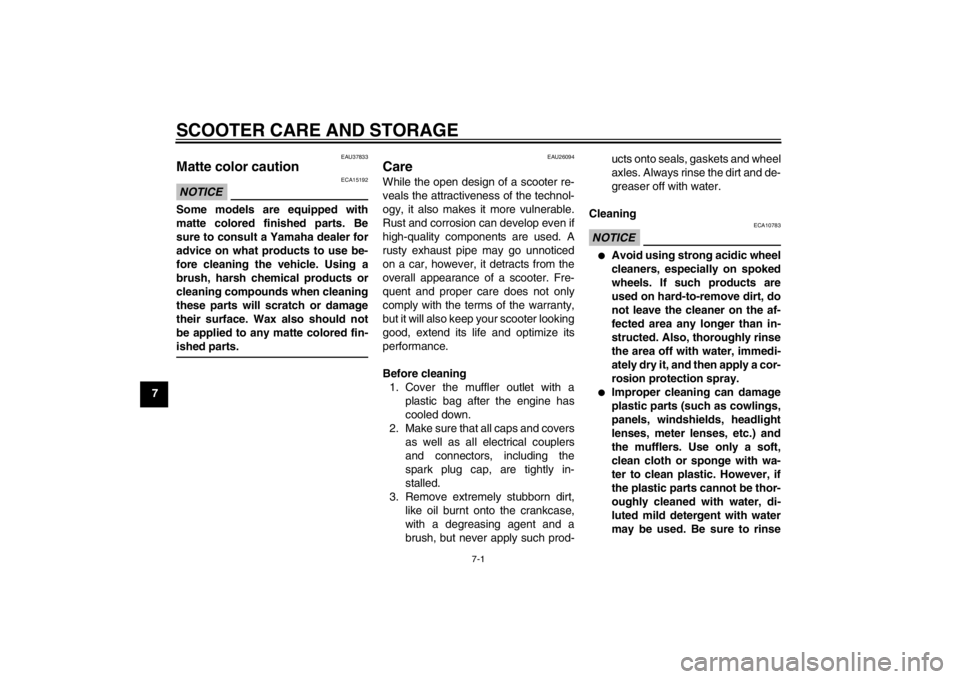
SCOOTER CARE AND STORAGE
7-1
7
EAU37833
Matte color caution NOTICE
ECA15192
Some models are equipped with
matte colored finished parts. Be
sure to consult a Yamaha dealer for
advice on what products to use be-
fore cleaning the vehicle. Using a
brush, harsh chemical products or
cleaning compounds when cleaning
these parts will scratch or damage
their surface. Wax also should not
be applied to any matte colored fin-
ished parts.
EAU26094
Care While the open design of a scooter re-
veals the attractiveness of the technol-
ogy, it also makes it more vulnerable.
Rust and corrosion can develop even if
high-quality components are used. A
rusty exhaust pipe may go unnoticed
on a car, however, it detracts from the
overall appearance of a scooter. Fre-
quent and proper care does not only
comply with the terms of the warranty,
but it will also keep your scooter looking
good, extend its life and optimize its
performance.
Before cleaning
1. Cover the muffler outlet with a
plastic bag after the engine has
cooled down.
2. Make sure that all caps and covers
as well as all electrical couplers
and connectors, including the
spark plug cap, are tightly in-
stalled.
3. Remove extremely stubborn dirt,
like oil burnt onto the crankcase,
with a degreasing agent and a
brush, but never apply such prod-ucts onto seals, gaskets and wheel
axles. Always rinse the dirt and de-
greaser off with water.
Cleaning
NOTICE
ECA10783
●
Avoid using strong acidic wheel
cleaners, especially on spoked
wheels. If such products are
used on hard-to-remove dirt, do
not leave the cleaner on the af-
fected area any longer than in-
structed. Also, thoroughly rinse
the area off with water, immedi-
ately dry it, and then apply a cor-
rosion protection spray.
●
Improper cleaning can damage
plastic parts (such as cowlings,
panels, windshields, headlight
lenses, meter lenses, etc.) and
the mufflers. Use only a soft,
clean cloth or sponge with wa-
ter to clean plastic. However, if
the plastic parts cannot be thor-
oughly cleaned with water, di-
luted mild detergent with water
may be used. Be sure to rinse
U1PHE0E0.book Page 1 Wednesday, August 29, 2012 4:42 PM
Page 65 of 74
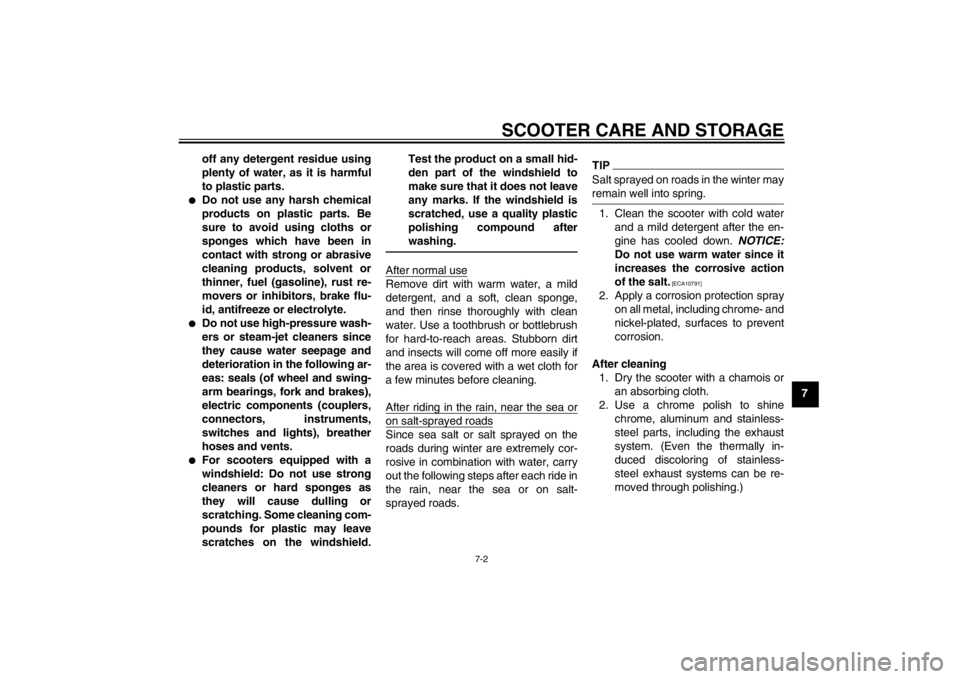
SCOOTER CARE AND STORAGE
7-2
7 off any detergent residue using
plenty of water, as it is harmful
to plastic parts.
●
Do not use any harsh chemical
products on plastic parts. Be
sure to avoid using cloths or
sponges which have been in
contact with strong or abrasive
cleaning products, solvent or
thinner, fuel (gasoline), rust re-
movers or inhibitors, brake flu-
id, antifreeze or electrolyte.
●
Do not use high-pressure wash-
ers or steam-jet cleaners since
they cause water seepage and
deterioration in the following ar-
eas: seals (of wheel and swing-
arm bearings, fork and brakes),
electric components (couplers,
connectors, instruments,
switches and lights), breather
hoses and vents.
●
For scooters equipped with a
windshield: Do not use strong
cleaners or hard sponges as
they will cause dulling or
scratching. Some cleaning com-
pounds for plastic may leave
scratches on the windshield.Test the product on a small hid-
den part of the windshield to
make sure that it does not leave
any marks. If the windshield is
scratched, use a quality plastic
polishing compound after
washing.
After normal useRemove dirt with warm water, a mild
detergent, and a soft, clean sponge,
and then rinse thoroughly with clean
water. Use a toothbrush or bottlebrush
for hard-to-reach areas. Stubborn dirt
and insects will come off more easily if
the area is covered with a wet cloth for
a few minutes before cleaning.
After riding in the rain, near the sea oron salt-sprayed roadsSince sea salt or salt sprayed on the
roads during winter are extremely cor-
rosive in combination with water, carry
out the following steps after each ride in
the rain, near the sea or on salt-
sprayed roads.
TIPSalt sprayed on roads in the winter may
remain well into spring.1. Clean the scooter with cold water
and a mild detergent after the en-
gine has cooled down. NOTICE:
Do not use warm water since it
increases the corrosive action
of the salt.
[ECA10791]
2. Apply a corrosion protection spray
on all metal, including chrome- and
nickel-plated, surfaces to prevent
corrosion.
After cleaning
1. Dry the scooter with a chamois or
an absorbing cloth.
2. Use a chrome polish to shine
chrome, aluminum and stainless-
steel parts, including the exhaust
system. (Even the thermally in-
duced discoloring of stainless-
steel exhaust systems can be re-
moved through polishing.)
U1PHE0E0.book Page 2 Wednesday, August 29, 2012 4:42 PM
Page 67 of 74
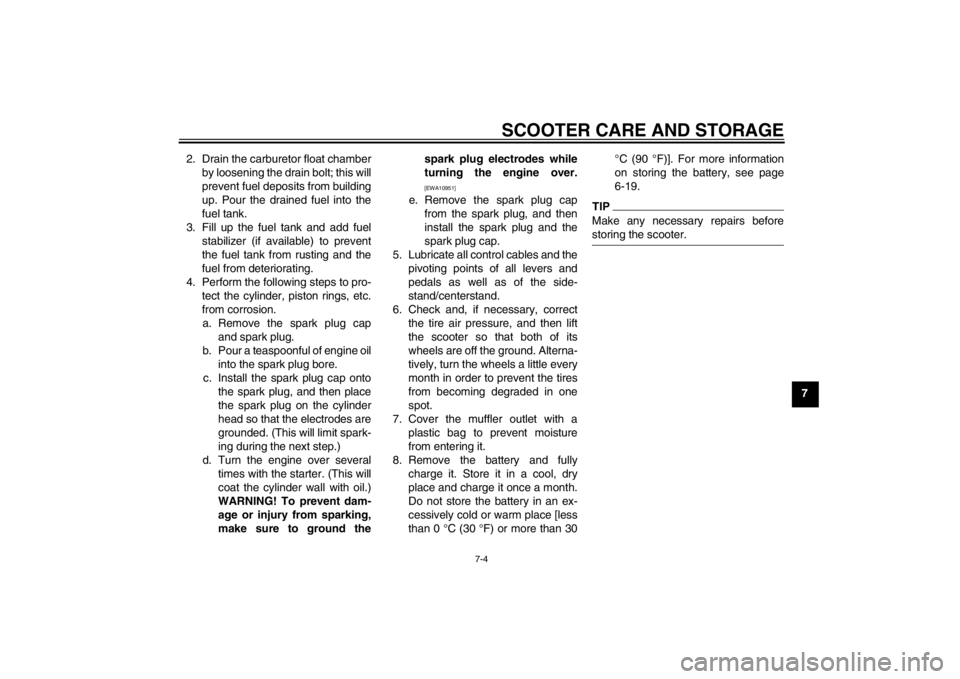
SCOOTER CARE AND STORAGE
7-4
7 2. Drain the carburetor float chamber
by loosening the drain bolt; this will
prevent fuel deposits from building
up. Pour the drained fuel into the
fuel tank.
3. Fill up the fuel tank and add fuel
stabilizer (if available) to prevent
the fuel tank from rusting and the
fuel from deteriorating.
4. Perform the following steps to pro-
tect the cylinder, piston rings, etc.
from corrosion.
a. Remove the spark plug cap
and spark plug.
b. Pour a teaspoonful of engine oil
into the spark plug bore.
c. Install the spark plug cap onto
the spark plug, and then place
the spark plug on the cylinder
head so that the electrodes are
grounded. (This will limit spark-
ing during the next step.)
d. Turn the engine over several
times with the starter. (This will
coat the cylinder wall with oil.)
WARNING! To prevent dam-
age or injury from sparking,
make sure to ground thespark plug electrodes while
turning the engine over.
[EWA10951]
e. Remove the spark plug cap
from the spark plug, and then
install the spark plug and the
spark plug cap.
5. Lubricate all control cables and the
pivoting points of all levers and
pedals as well as of the side-
stand/centerstand.
6. Check and, if necessary, correct
the tire air pressure, and then lift
the scooter so that both of its
wheels are off the ground. Alterna-
tively, turn the wheels a little every
month in order to prevent the tires
from becoming degraded in one
spot.
7. Cover the muffler outlet with a
plastic bag to prevent moisture
from entering it.
8. Remove the battery and fully
charge it. Store it in a cool, dry
place and charge it once a month.
Do not store the battery in an ex-
cessively cold or warm place [less
than 0 °C (30 °F) or more than 30°C (90 °F)]. For more information
on storing the battery, see page
6-19.
TIPMake any necessary repairs before
storing the scooter.
U1PHE0E0.book Page 4 Wednesday, August 29, 2012 4:42 PM
Page 68 of 74

SPECIFICATIONS
8-1
8
Dimensions:Overall length:
1870 mm (73.6 in)
Overall width:
NS50 700 mm (27.6 in)
NS50N 725 mm (28.5 in)
Overall height:
NS50 1155 mm (45.5 in)
NS50N 1115 mm (43.9 in)
Seat height:
815/930 mm (32.1/36.6 in)
Wheelbase:
1275 mm (50.2 in)
Ground clearance:
130 mm (5.12 in)
Minimum turning radius:
2000 mm (78.7 in)Weight:Curb weight:
97 kg (214 lb)Engine:Engine type:
Liquid cooled 2-stroke
Cylinder arrangement:
Single cylinder
Displacement:
49 cm³
Bore × stroke:
40.0 × 39.2 mm (1.57 × 1.54 in)
Compression ratio:
11.50–12.50 : 1
Starting system:
Electric starter and kickstarterLubrication system:
Separate lubrication (Yamaha autolube)
Engine oil:Type:
YAMALUBE 2S or 2-stroke engine oil
(JASO FC grade) or (ISO EG-C or EG-D
grade)
Engine oil quantity:
Quantity:
1.40 L (1.48 US qt, 1.23 Imp.qt)Final transmission oil:Type:
SAE 10W-30 type SE motor oil
Quantity:
0.11 L (0.12 US qt, 0.10 Imp.qt)Cooling system:Coolant reservoir capacity (up to the
maximum level mark):
0.25 L (0.26 US qt, 0.22 Imp.qt)
Radiator capacity (including all routes):
1.20 L (1.27 US qt, 1.06 Imp.qt)Air filter:Air filter element:
Wet elementFuel:Recommended fuel:
Premium unleaded gasoline only
Fuel tank capacity:
7.0 L (1.85 US gal, 1.54 Imp.gal)
Fuel reserve amount:
1.0 L (0.26 US gal, 0.22 Imp.gal)Carburetor:Type × quantity:
PHVA 12 ZS x 1
Spark plug(s):Manufacturer/model:
NGK/BR8HS
Spark plug gap:
0.6–0.7 mm (0.024–0.028 in)Clutch:Clutch type:
Dry, centrifugal automaticTransmission:Primary reduction ratio:
1
Final drive:
Gear
Secondary reduction ratio:
52/13 × 43/14 (12.286)
Transmission type:
V-belt automatic
Operation:
Centrifugal automatic typeChassis:Frame type:
Underbone
Caster angle:
27.00 °
Trail:
87 mm (3.4 in)Front tire:Type:
Tubeless
Size:
120/70-13 53P(Michelin)
53L(SAVA,Metzeler)
Manufacturer/model:
MICHELIN/POWER PURE SC
U1PHE0E0.book Page 1 Wednesday, August 29, 2012 4:42 PM
Page 69 of 74

SPECIFICATIONS
8-2
8
Manufacturer/model:
SAVA/ MC 16
Manufacturer/model:
METZELER/ ME 7 TEENRear tire:Type:
Tubeless
Size:
140/60-13 57P(Michelin)
57L(SAVA,Metzeler)
Manufacturer/model:
MICHELIN/POWER PURE SC
Manufacturer/model:
SAVA/ MC 16
Manufacturer/model:
METZELER/ ME 7 TEENLoading:Maximum load:
185 kg (408 lb)
(Total weight of rider, passenger, cargo and
accessories)Tire air pressure (measured on cold
tires):Loading condition:
0–90 kg (0–198 lb)
Front:
180 kPa (1.80 kgf/cm², 26 psi)
Rear:
200 kPa (2.00 kgf/cm², 29 psi)
Loading condition:
90–185 kg (198–408 lb)
Front:
190 kPa (1.90 kgf/cm², 28 psi)Rear:
220 kPa (2.20 kgf/cm², 32 psi)
Front wheel:Wheel type:
Cast wheel
Rim size:
13xMT3.00Rear wheel:Wheel type:
Cast wheel
Rim size:
13xMT3.50Front brake:Type:
Single disc brake
Operation:
Right hand operation
Specified brake fluid:
DOT 4Rear brake:Type:
Single disc brake
Operation:
Left hand operation
Specified brake fluid:
DOT 4Front suspension:Type:
Telescopic fork
Spring/shock absorber type:
Coil spring/oil damper
Wheel travel:
80.0 mm (3.15 in)
Rear suspension:Type:
Unit swing
Spring/shock absorber type:
Coil spring/oil damper
Wheel travel:
70.0 mm (2.76 in)Electrical system:Ignition system:
DC CDI
Charging system:
AC magnetoBattery:Model:
CB4-LB(GS)
Voltage, capacity:
12 V, 4.0 AhHeadlight:Bulb type:
IncandescenceBulb voltage, wattage × quantity:Headlight:
12 V, 35.0 W/35.0 W × 1
Tail/brake light:
12 V, 21.0 W/5.0 W × 1
Front turn signal light:
12 V, 10.0 W × 2
Rear turn signal light:
12 V, 10.0 W × 2
Auxiliary light:
12 V, 5.0 W × 2
Meter lighting:
LED
U1PHE0E0.book Page 2 Wednesday, August 29, 2012 4:42 PM
Page 72 of 74

INDEX22-stroke engine oil................................. 3-10AAcceleration and deceleration................. 5-2
Air filter element, cleaning..................... 6-10
Auxiliary light bulb, replacing
(if equipped)........................................ 6-24BBattery................................................... 6-19
Brake fluid, changing ............................ 6-16
Brake fluid level, checking .................... 6-15
Brake lever, front..................................... 3-7
Brake lever, rear ..................................... 3-7
Brake levers, lubricating........................ 6-17
Braking .................................................... 5-2CCarburetor,adjusting ............................. 6-11
Care ........................................................ 7-1
Catalytic converter ................................ 3-10
Centerstand, checking and
lubricating ........................................... 6-17
Coolant.................................................... 6-9
Coolant temperature warning light .......... 3-3
Cowling and panel, removing and
installing................................................ 6-6DDimmer switch ........................................ 3-7EEngine break-in ....................................... 5-3FFinal transmission oil .............................. 6-8
Front and rear brake lever free play,
checking ............................................. 6-14
Front and rear brake pads, checking .... 6-15Front fork, checking .............................. 6-18
Fuel......................................................... 3-9
Fuel and 2-stroke engine oil tank caps ... 3-8
Fuel consumption, tips for reducing........ 5-3
Fuel level warning light ........................... 3-3
Fuse, replacing ..................................... 6-21
HHandlebar switches ................................ 3-6
Headlight bulb, replacing ...................... 6-22
High beam indicator light ........................ 3-2
Horn switch ............................................. 3-7IIdentification numbers ............................ 9-1
Indicator lights and warning light ............ 3-2KKickstarter............................................. 3-11LLicense plate light ................................. 6-24MMain switch/steering lock........................ 3-1
Maintenance and lubrication, periodic .... 6-3
Maintenance, emission control
system .................................................. 6-2
Matte color, caution ................................ 7-1
Model label ............................................. 9-1
Multi-function display (NS50).................. 3-4OOil level warning light.............................. 3-2PParking ................................................... 5-4
Part locations .......................................... 2-1SSafe-riding points.................................... 1-5
Safety information................................... 1-1Seats ..................................................... 3-11
Shock absorber assembly,
adjusting (if equipped) ........................ 3-13
Spark plug, checking ............................... 6-7
Specifications .......................................... 8-1
Speedometer unit (NS50N) ..................... 3-3
Starting a cold engine ............................. 5-1
Starting off ............................................... 5-2
Start switch.............................................. 3-7
Steering, checking................................. 6-19
Storage.................................................... 7-3
Storage compartment............................ 3-12
TTail/brake light bulb, replacing .............. 6-23
Throttle grip and cable, checking and
lubricating ........................................... 6-17
Throttle grip free play, checking ............ 6-11
Tires ...................................................... 6-12
Troubleshooting .................................... 6-25
Troubleshooting charts.......................... 6-26
Turn signal indicator light ........................ 3-2
Turn signal light bulb, replacing ............ 6-23
Turn signal switch ................................... 3-7VVehicle identification number .................. 9-1WWheel bearings, checking ..................... 6-19
Wheels .................................................. 6-14
U1PHE0E0.book Page 1 Wednesday, August 29, 2012 4:42 PM